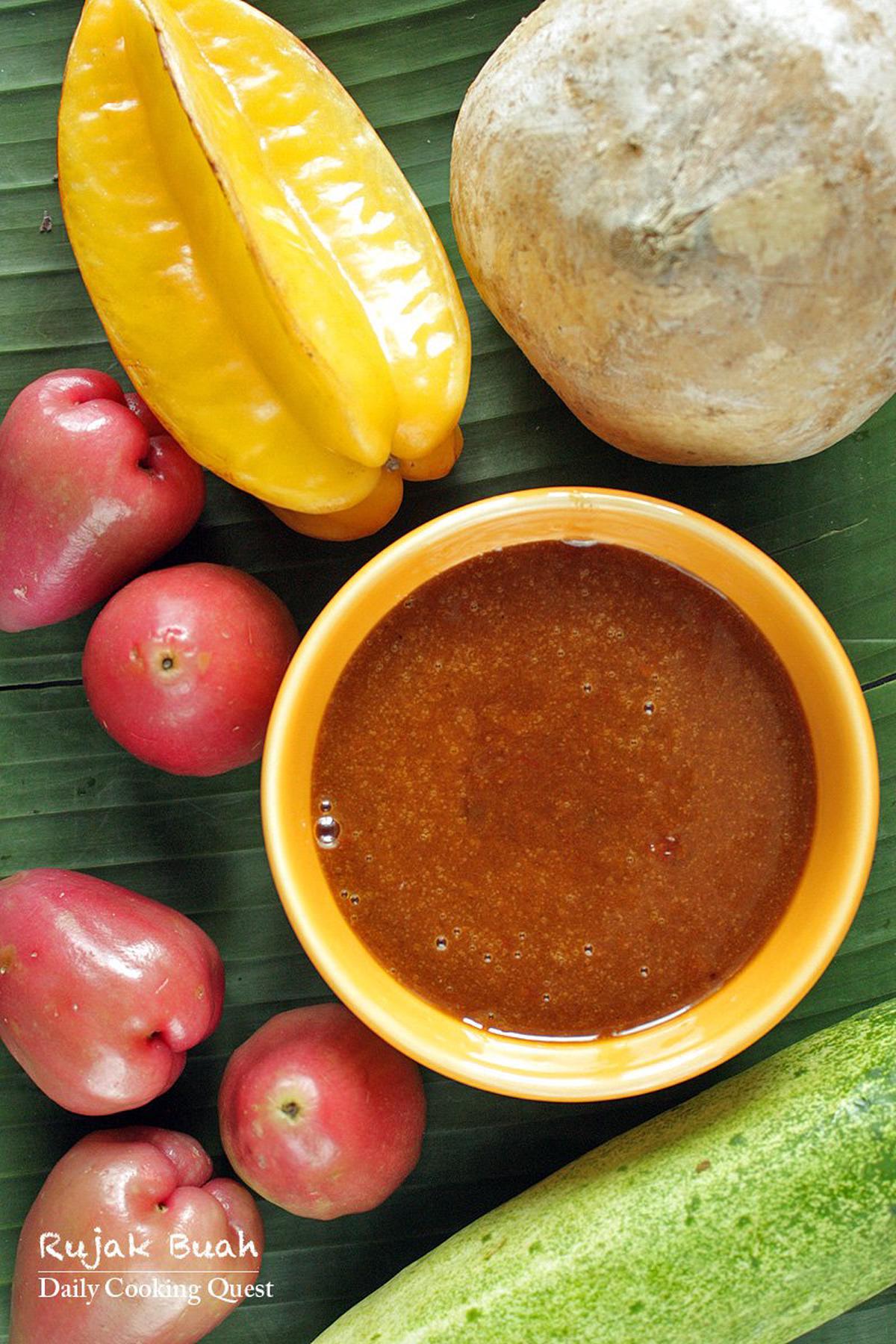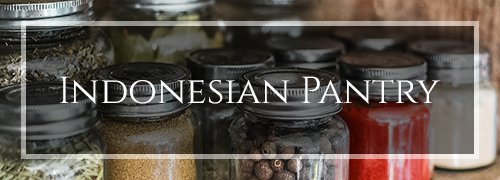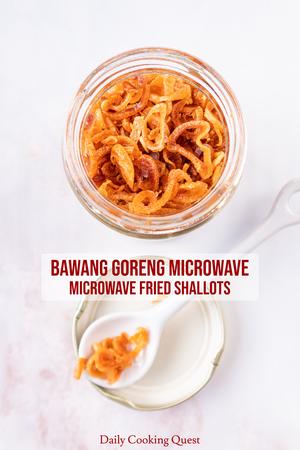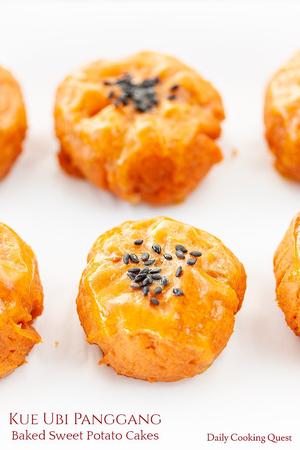Home / All Recipes / Indonesian / Rujak Buah - Fruit Salad with Spicy Palm Sugar Sauce
Rujak Buah - Fruit Salad with Spicy Palm Sugar Sauce
Let's make Indonesian rujak buah/fruit salad and serve it with the iconic spicy palm sugar sauce. This colorful salad is gluten-free and can feed a crowd.
What is rujak buah? Indonesian rujak buah, or rojak buah in Malaysia/Singapore, is basically a fruit salad. Picture a bowl of colorful slices of fruits and vegetables, dressed with sweet, spicy, and tangy palm sugar sauce, topped with ground peanuts, and you can understand why rujak/rojak is so beloved and always a popular choice among the locals. If you buy rujak from a street-food seller, your rujak may come in a banana leaves plate and a bamboo skewer! It looks super cute, and totally green since everything is biodegradable.

Which fruits and vegetables are typical in a rujak/rojak?
Some of the more popular fruit and vegetable choices that we use in a rujak include:
- green papaya (Indonesian: pepaya muda)
- green mango (Indonesian: mangga muda)
- pineapple (Indonesian: nenas)
- water apple/rose apple (Indonesian: jambu air)
- guava (Indonesian: jambu merah)
- cucumber (Indonesian: timun)
- jicama (Indonesian: bengkuang)
- star fruit (Indonesian: belimbing)
- ambarella (Indonesian: kedondong)
- pomelo (Indonesian: jeruk Bali)
Some of these fruits can be hard to find unless you have a very well-stocked Asian market. You can use other common firm fruits and vegetables too to make rujak, such as:
- apples, especially Granny Smith
- unripe pears, such as Bosc or d’Anjou
- Fuyu persimmon
- unripe melon/cantaloupe
- ripe but firm peaches/nectarines/plums
- carrot
- celery
- other firm fruits
Pretty much any fruit/vegetable that is firm enough that won’t fall apart when you try to pick it up with a skewer is a perfect candidate for rujak buah.
How to prepare spicy palm sugar dressing/sauce for rujak?
To make rujak dressing, you will need:
- palm sugar (Indonesian: gula Jawa/gula merah, Malaysian/Singaporean: gula melaka). You can use coconut sugar too, but please don’t use Thai palm sugar as the color is very pale and the dressing will not look the same.
- shrimp paste (Indonesian: terasi, Malaysian/Singaporean: belacan). This is another key ingredient that goes into a rujak dressing. Be sure to chop the amount needed from the big block and toast in a frying pan or a microwave until toasty, pale, fragrant, and crumbly.
- tamarind (Indonesian: asam Jawa). I usually buy wet seedless tamarind packet from Asian markets and mix the needed amount with water, then strained, to get tamarind juice.
- bird-eye chilies (Indonesian: cabe rawit). These chilies can be very hot and spicy. You can remove the seeds to reduce the heat. Feel free to use serrano or Fresno chilies to make a less spicy dressing.
Simply blend palm sugar, shrimp paste, tamarind juice, chilies, and salt in a food processor to turn them into a thick gooey liquid/syrup. You can serve the dressing immediately, or you can store it in the fridge for up to a week.
What are the differences between Indonesian and Malaysian/Singapore rujak?
Though both versions use plenty of fresh fruits and fresh vegetables, there are differences between the two versions:
- Malaysian/Singaporean rojak buah usually includes fried tofu, shrimp crackers, you tiau/cakwe/Chinese crullers, and even cuttlefish. Indonesian rujak buah, on the other hand, almost always only has fresh fruits and fresh vegetables.
- Malaysian/Singaporean rojak dressing usually has petis/dark liquid shrimp paste/he ko, this is not the same as terasi/belacan, though both are similarly pungent and stinky. :) Only a very specific rujak in Indonesia has this ingredient, and when this is used, we no longer call it rujak buah, instead, it is now called rujak petis.
Is there any other rujak in Indonesia?
Rujak buah is definitely our most popular rujak, but we have so many other varieties of rujak in Indonesia. Some of the more popular variants are:
- rujak bebek/rujak tumbuk. This is pretty much your typical mix of rujak buah, but all the fruits and vegetables are pounded in a mortar. Also, rujak bebek usually has green banana (Indonesian: pisang batu) and red yam (Indonesian: ubi merah).
- rujak serut. Also, pretty much rujak buah, but all the fruits and vegetables are shredded instead of cut up into slices.
- rujak petis. Again, this is our rujak where the dressing is made with petis/dark liquid shrimp paste/he ko instead of terasi/belacan. This rujak usually has kangkung, mung bean sprouts, tofu, and fried shallots/bawang goreng, on top of the usual mix of fresh fruits/vegetables.
- rujak juhi. This rujak has cuttlefish, tofu, potatoes, noodles, lettuce, cabbage, peanut sauce, garlic, and vinegar. Also, it is served with kerupuk (Indonesian crackers). This variety was originally created and enjoyed by Chinese Indonesians, but has since gained wide spread popularity and is now enjoyed throughout the country.
- rujak pengantin. Pengantin means bridge/groom, and this rujak has eggs, potatoes, tofu, pineapples, mung bean sprouts, acar (Indonesian pickles), lettuce, cabbage, and served with emping crackers, peanuts, and vinegary peanut sauce. Perhaps due to its name, this particular rujak is commonly served in Indonesian weddings. I know my parents served this at my own wedding. :)
Now I feel like I owe it to myself and everyone who reads my blog to share the rest of Indonesian rujak recipes.
Rujak Buah - Fruit Salad with Spicy Palm Sugar Sauce
Ingredients
- Rujak dressing/sauce
- 200 gram palm sugar (Indonesian: gula Jawa), chopped/shaved if using the block version
- 15 gram tamarind flesh + 5 tablespoon drinking water, strained
- 6 (or more) Thai chilies, seeded
- 1/4 teaspoon shrimp paste (Indonesian: terasi, Malaysian/Singaporean: belacan), toasted until pale, fragrant, and crumbly
- 1/4 teaspoon salt
- Typical fruits for rujak buah
- green mango (Indonesian: mangga muda)
- green papaya (Indonesian: pepaya muda)
- pineapple (Indonesian: nenas)
- water apple (Indonesian: jambu air)
- guava (Indonesian: jambu merah)
- cucumber (Indonesian: timun)
- jicama (Indonesian: bengkoang)
- starfruit (Indonesian: belimbing)
- ambarella (Indonesian: kedondong)
- pomelo (Indonesian: jeruk Bali)
- Optional toppings
- crushed/ground roasted peanuts
- toasted sesame seeds
- a mixture of salt and chili powder
Instructions
- Prepare rujak dressing/sauce. In a food processor/blender, process all rujak sauce ingredients into a thick gooey liquid. Transfer to a dipping bowl.
- Prepare fresh fruits. Wash and cut some of the suggested typical fruits and vegetables, make sure everything is bite-size pieces, arrange in individual serving/salad bowls.
- Serving rujak buah. Serve both the cut fruits and rujak sauce together. Pour a little bit of the spicy rujak sauce and mix with the fruits. If you wish, add the additional toppings too.






Comments
Gratefull!! Thanks a lot.
Leave a comment